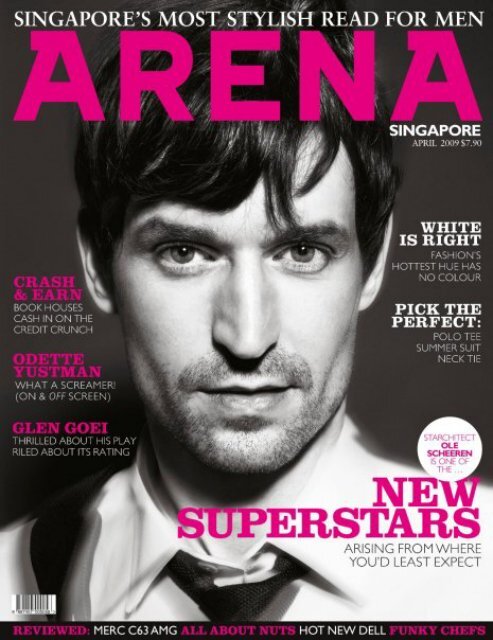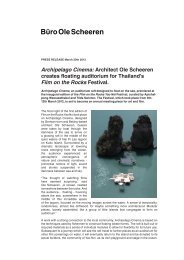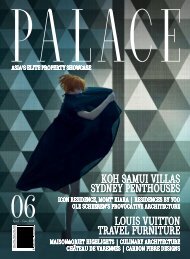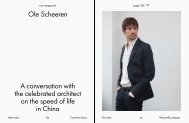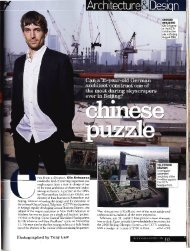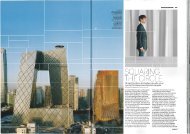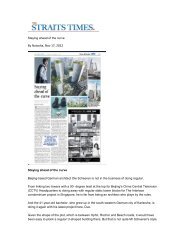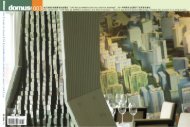200904 Arena Singapo.. - Buro Ole Scheeren
200904 Arena Singapo.. - Buro Ole Scheeren
200904 Arena Singapo.. - Buro Ole Scheeren
You also want an ePaper? Increase the reach of your titles
YUMPU automatically turns print PDFs into web optimized ePapers that Google loves.
<strong>Ole</strong>'s own cottonshirt, by Ann Demeulemeester.Grey silk suit,prices unavailable, bothby Louis Vuitton.<strong>Ole</strong> scheerenThe newsuperstarsHair Junie Tan Grooming June Goh/ Make Up For Ever Academy Fashion Assistant Glenn Gohthings like an entrance lobby, or somebits of the company’s projects.It was also in his youth that hediscovered what architecture couldultimately be for him. When he was 10,he flew with a friend to New York Citywhere he spent six weeks exploring thecity. “The experience of this super city,of this monstrous derelict urbanity…The sense of how a place lives, what it ismade of, what works and what doesn’t— I think this was really the beginning,”<strong>Scheeren</strong> muses.This inspired him to travel to manycountries in the world, to inhale thevibrancy of many cities. One of thesetrips would change his life. At 21, on awhim, he decided to take three monthsoff to backpack across China. Unlikenow, where every second headline onany newspaper is about the MiddleKingdom, <strong>Scheeren</strong> arrived when therewas no open tourism, and when theForeign Exchange Certificate (FEC), themoney that foreigners were made tospend, was still in use. He exchanged allhis FEC, then walked, biked and bussedthrough the entire country.“It changed my entire world view —all the European baggage of what I growup with, how I thought the world was,and how I thought things have to be. Isuddenly realised that everything can beentirely different. It was a totallyliberating experience,” he recollects.Then exactly 10 years later, he’s comefull circle, this time, liberating Beijing inthe form of his architecture.If there was but one word that coulddescribe <strong>Ole</strong> <strong>Scheeren</strong>, it would becomplex. Or maybe intense.Disciplined. Impulsive. Thoughtful.Perhaps idealistic. No, it’s impossible topigeonhole the enigmatic architect. Hedeclares the need for a dialecticmethodology as “on one hand I need tobe incredibly disciplined and coherent,and at the same time investigate theunpredictable and speculative.” ToWesterners, this might be contradictory,but, “to the Chinese mind, these areactually complementary,” he sayssmiling.But you’re European, and you’ve livedin Asia for many years now. Whichculture do you identify with most, I ask.“I think at a certain point things, reach alevel of complexity at which you can nolonger give a singular definition tosomething. I have been exposed todifferent cultures in living in Germany, inthe French part of Switzerland, Holland,then New York, London, Bangkok,China. I feel less attached to any specificculture, but rather, I am focused onwhatever context I subject myself to. Itgives me the possibility to discover thepotentials of each environment, extractfrom it, and try to fuse them into ahopefully productive psychology.”This amalgam of what makes up hispersonality extends even to his social life,“The CCTV Tower isa building that theChinese could havenever thought ofby themselves, andthe westernerscould neverhave built.”<strong>Ole</strong> scheerenwhich he says has no dichotomy betweenwork and free time. “My friends are oftenpeople I also work with. And the people Iwork with often become friends. There isno longer that kind of tension betweenbeing at work and being off work.”But one thing that seems to escapewhat he calls “the process of thought andproduction” or what we normally call“work” is his relationship with Chineseactress Maggie Cheung. He’s privateabout their relationship not because he’sshy to reveal such things but it’ssomething he’d rather I ask over a drinkthan a tape recorder. Besides, he trulybelieves it’s something people won’t beinterested in.But people do want to know, I counter,and he’s willing to go as far as to say,“She’s very important in my life, and weare very happy in our relationship. It issomething I am totally focused on, justnot in a public sense.”And indeed, it was his work, first, thatput him in the <strong>Arena</strong> spotlight. Actressgirlfriend: Check. First hit on a genericGoogle search: Check. Internationalrecognition: Check. Are architects thenew celebrities, I ask.“To be honest, I’ve never asked myselfthat question, and probably I refuse toask myself that question. I think as longas we do relevant work, it’s good. Aslong as what we do is meaningful, it’sgood, and that’s the most importantthing to focus on.”As partner of OMA, has yourwork moved from designing?When I started on the CCTV project atthe very beginning, the project team was60 architects and 120 engineers. Andwhile the architects were in one place, alot of the specialists or consultants werespread over many continents. I neededto coordinate everything, not only onthe level of timing, coherence and thetechnical concerns, but obviously alsothe cultural and creative aspects.How do you hold that manydifferent personalities andenergies together?You have to imagine a process that canultimately orchestrate such a group, andchannel them into a particular directionto produce such a building. I have to, onone hand, step back and look at theproject in its entirety, and on the other,have the ability to dive into particulardetails at any different point in time.So how autonomous do you letyour team be? Or do you like tohandle every little detail?I am extremely involved in every singleaspect of a project. Yet I guess myprimary role is to develop the concept ofa project in the greater context and thendefine which direction it should take.Architecture exists both in theimaginative world of the concept, butalso in the actual world of the builtphysical object. And that is ultimatelycomposed of an infinite amount ofdetails. So it’s really all about piecingboth together.099 April 09
<strong>Ole</strong> scheerenThe newsuperstarsOtherStarchitects“ I actually never worea single piece of Prada theentire time we workedon the project. ”<strong>Ole</strong> scheerenClockwisefrom top: CCTVHeadquarters, Beijing.Prada Epicentre, newyork. the ScottsTower, <strong>Singapo</strong>re.Photos Ou Qiang/oma (CCTV HQ & Scotts Tower) & OMA (Prada epicentre)From public to privatebuildings, such as the ScottsTower you designed, do youfeel your ideas will findacceptance more easily?Each context has its own set ofadvantages and disadvantages. And Ithink China is an environment in whichnot everything has been tested yet, notevery system has been developed. It is anenvironment that is incredibly open todeveloping new ways of doing things.And that bears a potential to do veryunexpected things.Miuccia has a reputation forbeing detailed. How was it likeworking with her?Well, actually working with Miucciawas an incredible experience because itwas one of the rare occasions to have anextraordinarily sophisticated client, andsomeone who has her own vision. Youseem to describe it as instructiveprecision, but I think it was much moreof a collaborative interest. Herintelligence meant that there weremoments of very clear and preciseinteraction. But also, at the same time,she gave us a huge spectrum of freedom.Miuccia and I ended up two weeks inthe store, on our knees, testing andexperimenting how to bring themerchandise into this environment,imagining not only the space, but alsothe way that things would inhabit andinteract with the space. Together, weliberated it from simply being a store;we made it a cultural space.Was there pressure toaccommodate?I actually never wore a single piece ofPrada the entire time we worked on theproject.Some Beijingers have taken tocalling it the “Underpantsbuilding” because of its shape.How does this talk affect you?Well, I think that’s rather funny. Aproject that stirs public debate isincredibly positive. Positive in the sensethat it engages the public mind and makespeople think about what architecture is,what it can be for their city, for their lives,for their environment. I think that this isthe most important contribution thatCCTV has made or still can make beyondits physical existence, beyond the fact thatit is just an object in the city. It illustratesthat architecture might not have to bewhat it’s always assumed to be, tofunction, or look the way it’s supposed orexpected to look.it certainly looks unexpected.The building stands really as a symbol ofcollaboration between the Western criticalthinking of architecture and a kind ofChinese sensibility, and both have reallymerged in the towers. It’s a building thatthe Chinese could have never thought ofby themselves, and the Westerners couldnever have built. It was clear that thisproject posed the question: How couldwe, with our Western sensitivities createsomething together with the local culture?when CCTV was calling for designproposals, The New York WorldTrade Centre project was also upfor grabs, which OMA gave up tofocus on the CCTV tower. Anyregrets?We did not for a second care about thequestion: Which one would be moreprestigious, but simply which one wouldbe of the greater potential, botharchitecturally and socially. There is reallynot a split second of regret, though itwould be extremely exciting to do aproject in New York at some point intime.Can architecture change theworld?I think that would be way too optimistica declaration. I don’t think we could everbe as arrogant as claiming that because abuilding is in the end nothing more than acontainer for people. But obviously, thereis a hope that architecture can make acontribution to where things are going,to what is possible and to imagine whatcould be.Jean Nouvel, 63Fumel, Lot-et-Garonne, FranceFounder, Mars 1976, Syndicat del’ArchitectureBecause his designs remind us howdramatic architecture can be.Nouvel was awarded the PritzkerPrize in 2008, for his work on morethan 200 projects, including the ArabWorld Institute in Paris and the TorreAgbar in Barcelona. His designs havea penchant for attracting superlativeslike “dramatic”, “defiant” and“eccentric”, cementing him as a truearchitectural celebrity.Daniel Libeskind, 62ŁódZ, PolandArchitect, Studio Daniel LibeskindBecause he dares to dream — anddesign — big.Libeskind has been chosen as themaster plan architect for thereconstruction of the World TradeCenter site — astonishing, given thatcritics had labelled the designs duringhis early career as “unbuildable”. Hisworks have been exhibited in majorgalleries around the world, includingthe Bauhaus Archives and theMuseum of Modern Art: Proof thathe has left those critics in his dust.100 April 09101 April 09


